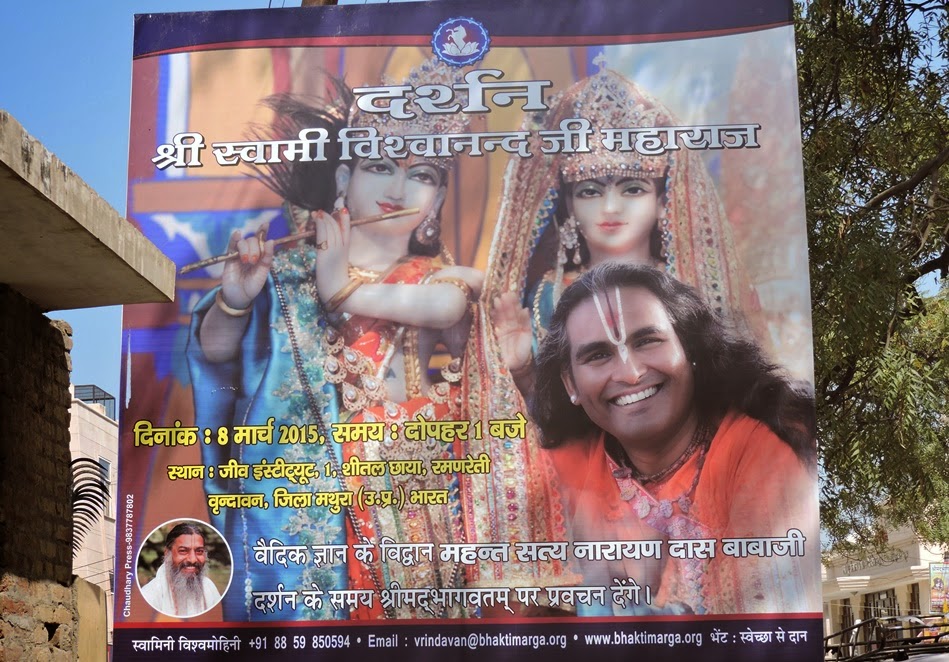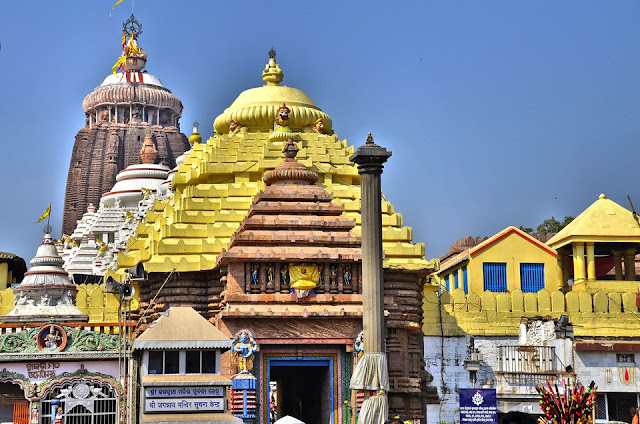The story of Bhagavat Rasik Dev
I have been reading a book by Suryakant Goswami, a sevadhikari at the Bankey Bihari temple, called Nikunj ka rahi, or “Pilgrim to the Secret Grove.” The story is about Bhagavat Rasik Dev, an early 19th century saint of the Haridasi or Sakhi sampradaya. The story is itself of great interest, and the telling is done in good, literary Hindi.
Goswami’s descriptions of Vrindavan as it was in the first half of the 19th century fills a reader like myself with nostalgia, though some of the things that he describes — large homes for absentee rich people, for instance — show that certain trends are eternal, only being exacerbated by India’s current economic boom.
Bhagavat Rasik Dev was a grand disciple of Lalita Kishori Das, the founder of the Tattiya Sthan. On one of his first days in Vrindavan, after bathing in the Yamuna, he had a vision of Swami Haridas with the Divine Couple sitting in his lap, like in the picture above.
But when he came to stay permanently in Vrindavan and took vesh from his guru, Lalita Mohini Das, from his desire to do bhajan, he made a decision not to stay there, but to move to Radha Bawri in Rajpur, which in those times was very isolated. His desire to meditate on the Nitya Vihar in seclusion was too strong for him, and he found that Tattiya Sthan was becoming unsuitable for that purpose.
I recently went to Tattiya Sthan, and I can see the general increase in activity there that has accompanied the general rajasic mode in Vrindavan. More sadhus, more visitors, more disturbance. But in comparison to the rest of Vrindavan it is still a real oasis.
Radha Bawri, as I recently pointed out, is comparatively more isolated, but not at all out of danger in the modern mad rush to development. But for Bhagavat Rasik, the new formation of a community of sadhus and the culture of sadhu seva that was being implanted there meant that cooking had taken on increased importance, and along with it the complications of collecting, cooking, managing, and organizing.
Bhagavat Rasik prefered to subsist on madhukari, which was common for most renounced Vaishnavas of the time. Madhukari means going once a day to a few homes and begging for a piece of bread, usually a corner torn from one of those thick Brijvasi rotis, from a few houses. The sadhus at Radha Bawri still follow this custom. Two of the babas go out each day through the local neighborhoods and come back with enough rotis for the whole ashram. They eat this with chanch (buttermilk) from their sizable goshala and a bit of kitcherie or vegetable from their own garden, when they have. It is a very simple diet. I had one of these madhukari rotis when I was there the other day and I can attest that it was pure magic, but for modern taste in variety it would be a tough sell.
And it may be said that the bhandara culture for many of the madhukari sadhus was looked down on. “One who runs here and there out a desire to fill his belly and gratify the tongue does not get Krishna,” would be their motto.
Bhagavat Rasik was learned in the scriptures and a good speaker even before coming to Vrindavan. He was, as his guru-given name indicates, a rasik and an accomplished poet. His spiritual practice was to remember the nitya nikunj and Radha and Krishna’s nitya-vihar. But because his wisdom, his renunciation and his love for his practice were so great, his reputation rapidly grew. His songs were sung and because he asked for nothing, he was loved by rich and poor alike.
But this caused some resentment in Tattiya Sthan. The devotees there, rather than rejoicing in his spiritual progress, felt that he was implicitly criticizing their practice. No doubt he had said something of the sort. Now Bhagavat Rasik participated in the general mood of the time, which was to seek a synthesis of the different strands of Radha-Krishna worship in Vrindavan and a friendly relation with those belonging to other sects.
As with most religious communities, there were in Vrindavan periodic flurries of sectarian wrangling over issues of legitimacy, doctrine and practice. In the 18th century, the “four sampradaya” solution was presented, as those in the Gaudiya sampradaya well know. At this time, the sadhus of Tattiya Sthan decided to affiliate themselves with the Nimbark sampradaya in order to gain Chari Sampradaya legitimacy.
It should be noted here in passing that there are many differences between the versions of history such as the life of Haridas Swami as given by the renounced Vaishnavas of the Haridasi sampradaya and those who are householders serving Bankey Bihariji. I tend to give a bit more credence to the version of the householders because the oral histories would be more reliable in such kinds of brahmin families where genealogy is of such importance. The Bankey Bihari Gosais are related to Swami Haridas through his brothers, who were the first sevayats. The Gosais say that Swami Haridas was from the Vishnuswami Sampradaya. The two branches have different tilak.
Anyway, that is a story for another day.
One of the problems with the Chari Sampradaya system was that the Samaj imposed certain standards on its members. These standards unfortunately included rules around food based in caste consciousness. Now in the Gaudiya sampradaya, those who do madhukari go to every Brijbasi’s house, without any regard for caste. They will even accept rotis from outcastes because they feel that caste has no meaning in the Holy Dham. But those who participate in the Samaj, which means going to each other’s feasts and celebrations, will not take any food or water from lower castes. Were they to do so, members of other lineages will not accept their invitations.
Bhagavat Rasik made the fatal “mistake” of taking madhukari from a low caste washerman (dhobi) household and this was objected to by sadhus both in Tattiya Sthan and when they got wind, other leading sadhus from the Samaj. It became an important enough issue that it was taken to Lalita Madhuri Das, the Mahant, for judgment. Bhagavat Rasik was summoned, tried and found guilty. His argument was: Why make a distinction between castes? All birth in this world is kujāt.
The Mahant sided with the Samaj. Bhagavat Rasik’s punishment was banishment from Vrindavan.
Bhagavat Rasik took his exile in good grace and without any ado, accompanied by a few disciples, walked along the Yamuna as far as Prayag and settled in Arail, where Vallabhacharya had once lived. There he continued his bhajan but he never returned to Vrindavan, dying in Allahabad.
Interestingly, Suryakant Goswami, though a brahmin, takes the side of Bhagavat Rasik. He has Lalit Mohini Das — who is also known for his literary contributions to the sect — torn between the need to keep harmony in his community and his respect for his own disciple, whom he recognized as a great devotee.
As is usually the case with the historical residue of such stories, it is somewhat difficult to assess the extent of the emotions that were prevalent in this kind of incident, but perhaps the following song by Bhagavat Rasik will give a clue:
celā kāhū ke nahīṁ guru kāhu ke nāhiṁ
sakhī laḍaitī lāla kī rahaiṁ mahala ke māhiṁ
rahaiṁ mahala ke māhiṁ ṭahala hama kareṁ nirantara
dampati ati akulāhiṁ palaka kahum parai ju aṁtara
bhagavata bhagavata kahaiṁ karaiṁ nahiṁ hama bina kelā
tāte hama parihare deha-mānī guru celā
Nobody is anyone’s disciple and no one is anyone’s guru. The sakhis stay in the palace of the Divine Prince and Princess. They stay in the palace and constantly move hither and thither in their service. And the sakhis gaze upon them with unblinking eyes, not even a moment missed. The devotee Bhagavata Rasik says, “We do not do anything but play. And so we have no need for a guru-disciple relationship based on the material body.”
Interestingly, I asked the Mahant at Radha Bawri whether they still follow the madhukari rule, and he said “We have to follow the rules imposed by the Samaj.”



Comments